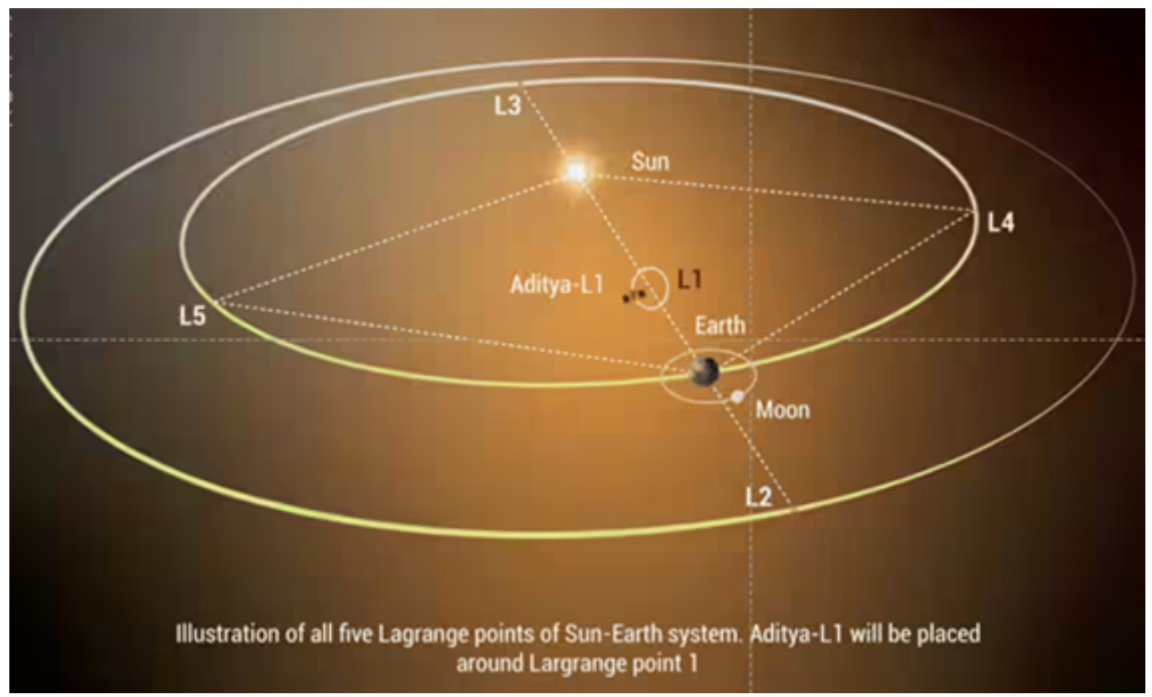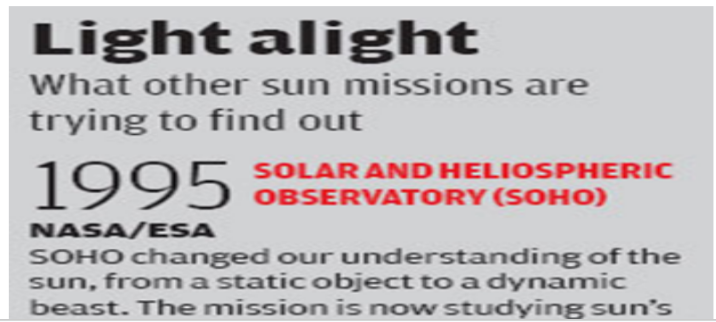Context:
Recently, the Indian Space Research Organisation (ISRO) launched Aditya L-1, its first space-based mission to study the Sun, from the Satish Dhawan Space Centre in Sriharikota.
About Aditya-L1 Mission:
- Aditya-L1 is the first Indian space mission to observe the Sun and the solar corona.
- The meaning of Aditya is “Sun God”.

- It will be placed in a halo orbit around the first Lagrange point (L1) of the Sun-Earth system which allows it to look at the Sun continuously.
- PSLV-C57: It is the 25th mission using PSLV-XL configuration.
Major Science Objectives of Mission:
- Study:
- Solar upper atmospheric (chromosphere and corona) dynamics.
- Chromospheric and coronal heating.
- Physics of the partially ionized plasma.
- Initiation of the Coronal Mass Ejections (CME).
- Solar Flares.
- Observe:
- In-situ particle and plasma environment providing data for the study of particle dynamics from the Sun.
- Physics of solar corona and its heating mechanism.
- Diagnostics of the coronal and coronal loops plasma: Temperature, Velocity and Density.
- Development, dynamics and origin of CMEs.
- Identify the sequence of processes that occur at multiple layers which leads to solar eruptive events.
- Identify magnetic field topology and magnetic field measurements in the solar corona.
- Identify the drivers for space weather.
Associated Concepts:

- Sun’s Corona: It is the outermost layer of the Sun. The corona’s high temperature causes its particles to move at very high speeds. These speeds are so high that the particles can escape the Sun’s gravity.
- Space Weather: It refers to changing environmental conditions in space. It is mainly influenced by activity on the Sun’s surface like solar wind, magnetic field, etc.
- Chromosphere: It is a layer of gas above a star’s photosphere with temperature ranging from 6,000 to 20,000 degree Celsius. It is the transition between corona and the photosphere. The temperature rises as the chromosphere moves farther away from the Sun unlike other objects of the solar system.
- CME: These are the large eruption of magnetized plasma from corona that propagates outward into interplanetary space.
- Solar Flares: It is an intense burst of radiation coming from the release of magnetic energy associated with sunspots. They are seen as bright areas in the sun and they can last from minutes to hours.
- Plasma: It is a gas that is so hot that some or all its constituent atoms are split up into electrons and ions, which can move independently of each other. It is the fourth state of matter.
About Lagrange Points:

- They have been named after Italian-French mathematician Joseph-Louis Lagrange.
- There are five Lagrange points, L1 to L5, between any two-celestial body system.
- At these positions, the gravitational pull of the celestial bodies equals the centripetal force, thus the forces acting on the third body cancel each other out.
- The L1 point of the Earth-Sun system provides an uninterrupted view of the sun and is currently home to the Solar and Helio spheric Observatory Satellite SOHO.
- According to NASA, the points can be used as ‘parking spots’ for spacecraft in space to remain in a fixed position with minimal fuel consumption.
Significance of Aditya L-1 Mission:
- Observe Solar Activities: It promises to provide crucial insights into the Sun’s activities and their implications for the Earth.
- For instance, the mission aims to comprehend how solar storms generate high-energy charged particles that can potentially damage satellites and disrupt our modern way of life.
- Space Weather Prediction: Aditya-L1 holds the promise of providing us with the knowledge to predict space weather.
- For instance, it will monitor the near-Earth space environment and contribute to refining space weather forecasting models.
 Severe space weather impacts telecommunication and navigational networks, high-frequency radio communications, air traffic on polar routes, electric power grids and oil pipelines at high latitudes of the Earth.
Severe space weather impacts telecommunication and navigational networks, high-frequency radio communications, air traffic on polar routes, electric power grids and oil pipelines at high latitudes of the Earth.
- International Leadership and Prestige: The ambitious mission marks the country’s inaugural journey into space-based solar studies. ISRO will join the ranks of NASA and the European Space Agency to station a solar observatory there.
- Placing Satellite in a Halo Orbit: It is situated outside Earth’s atmosphere and magnetosphere thus it remains unaffected by Earth. Moreover, a satellite experiences much fewer mechanical and thermal disturbances thus it is more stable.
- Scientific Discovery: Solar missions often lead to unexpected discoveries and new insights into the Sun’s behaviour.
- For example, the Parker Solar Probe, launched by NASA, has provided new data about the solar wind.
- Other Advantages: Apart from the primary pursuit of the scientific goals, the impact of the mission extends to critical aspects of industry and society.
- For example, space-based solar studies help in creating scientific and technical jobs, enhance safety on Earth, and increase international collaboration among different countries.
Challenges:
- L1 Point Distance: Navigating a spacecraft requires extremely precise calculations and manoeuvres to ensure it remains on its desired trajectory. The Sun’s gravitational pull and the spacecraft’s high speed can complicate navigation.
- Exposure to Sun’s Heat: Proximity to the Sun exposes spacecraft to extreme temperatures and intense radiation.
- To withstand these conditions, solar missions require advanced materials and thermal protection systems to ensure functioning of moving components.
- Power Generation: Solar missions must rely on solar panels to generate power. However, as they get closer to the Sun, the intensity of sunlight becomes too intense for conventional solar panels to generate power for the spacecraft’s operation.
- Communication: The interference from the Sun’s radio emissions with a spacecraft transmitting data over such vast distances hinders communication.
- Data Collection: Precise calibration of scientific instruments is crucial to ensure the accuracy of data collected during a solar mission, but the extreme environment makes it a challenging task.
Way Forward:
- Advanced Instruments Development: Investing in the development of advanced solar observation instruments and technology including improving data collection capabilities, precision of measurements, and enhancing the longevity of instruments.
- International Cooperation: India should seek international cooperation in space exploration with like-minded players like the USA, ESA etc.
- International Competition: India needs to strive for leadership in solar science and technology to better understand the Sun and space weather phenomena.
- Education: Engaging with the public and educational institutions to promote interest in space science. This can help foster the development of future scientists and engineers.
- Funding: Such missions require long-term planning and financial commitment and it is important to ensure a supportive space policy environment and adequate funding.
- Data Utilisation: Effective utilisation of the data collected from solar missions can maximize the scientific return on investment.
News Source: Down To Earth
![]() 4 Sep 2023
4 Sep 2023



 Severe space weather impacts telecommunication and navigational networks, high-frequency radio communications, air traffic on polar routes, electric power grids and oil pipelines at high latitudes of the Earth.
Severe space weather impacts telecommunication and navigational networks, high-frequency radio communications, air traffic on polar routes, electric power grids and oil pipelines at high latitudes of the Earth.